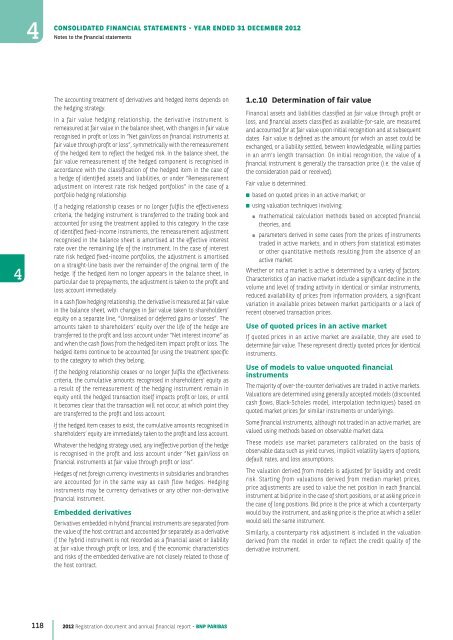2012 Registration document and annual financial report - BNP Paribas
2012 Registration document and annual financial report - BNP Paribas
2012 Registration document and annual financial report - BNP Paribas
- No tags were found...
You also want an ePaper? Increase the reach of your titles
YUMPU automatically turns print PDFs into web optimized ePapers that Google loves.
4CONSOLIDATEDFINANCIAL STATEMENTS - YEAR ENDED 31 DECEMBER <strong>2012</strong>Notes to the <strong>financial</strong> statements4The accounting treatment of derivatives <strong>and</strong> hedged items depends onthe hedging strategy.In a fair value hedging relationship, the derivative instrument isremeasured at fair value in the balance sheet, with changes in fair valuerecognised in profit or loss in “Net gain/loss on <strong>financial</strong> instruments atfair value through profit or loss”, symmetrically with the remeasurementof the hedged item to reflect the hedged risk. In the balance sheet, thefair value remeasurement of the hedged component is recognised inaccordance with the classification of the hedged item in the case ofa hedge of identified assets <strong>and</strong> liabilities, or under “Remeasurementadjustment on interest rate risk hedged portfolios” in the case of aportfolio hedging relationship.If a hedging relationship ceases or no longer fulfils the effectivenesscriteria, the hedging instrument is transferred to the trading book <strong>and</strong>accounted for using the treatment applied to this category. In the caseof identified fixed-income instruments, the remeasurement adjustmentrecognised in the balance sheet is amortised at the effective interestrate over the remaining life of the instrument. In the case of interestrate risk hedged fixed-income portfolios, the adjustment is amortisedon a straight-line basis over the remainder of the original term of thehedge. If the hedged item no longer appears in the balance sheet, inparticular due to prepayments, the adjustment is taken to the profit <strong>and</strong>loss account immediately.In a cash flow hedging relationship, the derivative is measured at fair valuein the balance sheet, with changes in fair value taken to shareholders’equity on a separate line, “Unrealised or deferred gains or losses”. Theamounts taken to shareholders’ equity over the life of the hedge aretransferred to the profit <strong>and</strong> loss account under “Net interest income” as<strong>and</strong> when the cash flows from the hedged item impact profit or loss. Thehedged items continue to be accounted for using the treatment specificto the category to which they belong.If the hedging relationship ceases or no longer fulfils the effectivenesscriteria, the cumulative amounts recognised in shareholders’ equity asa result of the remeasurement of the hedging instrument remain inequity until the hedged transaction itself impacts profit or loss, or untilit becomes clear that the transaction will not occur, at which point theyare transferred to the profit <strong>and</strong> loss account.If the hedged item ceases to exist, the cumulative amounts recognised inshareholders’ equity are immediately taken to the profit <strong>and</strong> loss account.Whatever the hedging strategy used, any ineffective portion of the hedgeis recognised in the profit <strong>and</strong> loss account under “Net gain/loss on<strong>financial</strong> instruments at fair value through profit or loss”.Hedges of net foreign currency investments in subsidiaries <strong>and</strong> branchesare accounted for in the same way as cash flow hedges. Hedginginstruments may be currency derivatives or any other non-derivative<strong>financial</strong> instrument.Embedded derivativesDerivatives embedded in hybrid <strong>financial</strong> instruments are separated fromthe value of the host contract <strong>and</strong> accounted for separately as a derivativeif the hybrid instrument is not recorded as a <strong>financial</strong> asset or liabilityat fair value through profit or loss, <strong>and</strong> if the economic characteristics<strong>and</strong> risks of the embedded derivative are not closely related to those ofthe host contract.1.c.10 Determination of fair valueFinancial assets <strong>and</strong> liabilities classified as fair value through profit orloss, <strong>and</strong> <strong>financial</strong> assets classified as available-for-sale, are measured<strong>and</strong> accounted for at fair value upon initial recognition <strong>and</strong> at subsequentdates. Fair value is defined as the amount for which an asset could beexchanged, or a liability settled, between knowledgeable, willing partiesin an arm’s length transaction. On initial recognition, the value of a<strong>financial</strong> instrument is generally the transaction price (i.e. the value ofthe consideration paid or received).Fair value is determined:■ based on quoted prices in an active market; or■ using valuation techniques involving:■mathematical calculation methods based on accepted <strong>financial</strong>theories, <strong>and</strong>■ parameters derived in some cases from the prices of instrumentstraded in active markets, <strong>and</strong> in others from statistical estimatesor other quantitative methods resulting from the absence of anactive market.Whether or not a market is active is determined by a variety of factors.Characteristics of an inactive market include a significant decline in thevolume <strong>and</strong> level of trading activity in identical or similar instruments,reduced availability of prices from information providers, a significantvariation in available prices between market participants or a lack ofrecent observed transaction prices.Use of quoted prices in an active marketIf quoted prices in an active market are available, they are used todetermine fair value. These represent directly quoted prices for identicalinstruments.Use of models to value unquoted <strong>financial</strong>instrumentsThe majority of over-the-counter derivatives are traded in active markets.Valuations are determined using generally accepted models (discountedcash flows, Black-Scholes model, interpolation techniques) based onquoted market prices for similar instruments or underlyings.Some <strong>financial</strong> instruments, although not traded in an active market, arevalued using methods based on observable market data.These models use market parameters calibrated on the basis ofobservable data such as yield curves, implicit volatility layers of options,default rates, <strong>and</strong> loss assumptions.The valuation derived from models is adjusted for liquidity <strong>and</strong> creditrisk. Starting from valuations derived from median market prices,price adjustments are used to value the net position in each <strong>financial</strong>instrument at bid price in the case of short positions, or at asking price inthe case of long positions. Bid price is the price at which a counterpartywould buy the instrument, <strong>and</strong> asking price is the price at which a sellerwould sell the same instrument.Similarly, a counterparty risk adjustment is included in the valuationderived from the model in order to reflect the credit quality of thederivative instrument.118<strong>2012</strong> <strong>Registration</strong> <strong>document</strong> <strong>and</strong> <strong>annual</strong> <strong>financial</strong> <strong>report</strong> - <strong>BNP</strong> PARIBAS





